实验八 进程间通信
1.举例说明使用匿名管道进行进程通信。
匿名管道:当进程使用 pipe 函数,就可以打开位于内核中的这个特殊“文件”。同时 pipe 函数会返回两个描述 符,一个用于读,一个用于写。如果你使用 fstat 函数来测试该描述符,可以发现此文件类型为 FIFO 。而无名管道的无名,指的就是这个虚幻的“文件”,它没有名字。
可以使用man 进入帮助手册。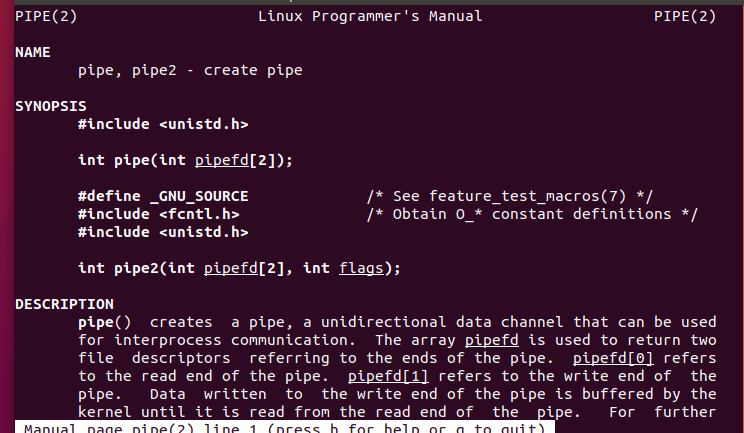
pipe 函数打开的文件描述符是通过参数(数组)传递出来的,而返回值表示打开成功(0)或失败(-1)。 它的参数是一个大小为 2 的数组。此数组的第 0 个元素用来接收以读的方式打开的描述符,而第 1 个元素用来接收以写的方式打开的描述符。也就是说, pipefd[0] 是用于读的,而 pipefd[1] 是用于写的。
打开了文件描述符后,就可以使用 read(pipefd[0]) 和 write(pipefd[1]) 来读写数据了。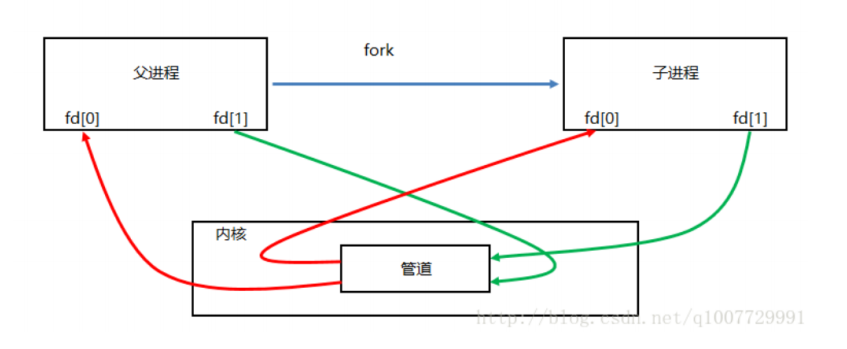
注意事项:这两个分别用于读写的描述符必须同时打开才行,否则会出问题。
如果关闭读 ( close(pipefd[0]) ) 端保留写端,继续向写端 ( pipefd[1] ) 端写数据( write 函数)的进程会收到 SIGPIPE 信号。 如果关闭写 ( close(pipefd[1]) ) 端保留读端,继续向读端 ( pipefd[0] ) 端读数据( read 函数), read 函数会返回 0.
例题:父进程 fork 出一个子进程,通过无名管道向子进程发送字符,子进程收到数据后将字符串中的小写字符转换成大写并输出。
//hellopipe.c
#include <stdio.h>
#include <unistd.h>
#include <stdlib.h>
#include <ctype.h>
void child(int *fd) {
close(fd[1]); // 子进程关闭写端
char buf[64];
int n = 0,i;
while(1) {
n = read(fd[0], buf, 64);//如果没有数据可读,read会阻塞;如果父进程退出,read返回0.
for (i = 0; i < n; ++i)
putchar(toupper(buf[i])); //toupper把小写字母转换为大写字母
if (*buf == 'q') {
close(fd[0]);
exit(0);
}
if (n == 0) {
puts("no data to read!");
sleep(1);
}
}
exit(0);
}
int main() {
int fd[2];//作为传出参数
int n = 0;
char buf[64] = { 0 };
if (pipe(fd) < 0) { //报错
perror("pipe");
return -1;
}
pid_t pid = fork(); //产生子进程
if (pid == 0) {
child(fd);
}
close(fd[0]);// 父进程关闭读端
while (1) {
n = read(STDIN_FILENO, buf, 64);//读取标准输入到buf中,返回读取字节数
write(fd[1], buf, n);
if (*buf == 'q') {
close(fd[1]);
exit(0);
}
}
return 0;
}


命名管道
-
通过命令 mkfifo 创建管道
man mkfifo![]()
-
通过函数 mkfifo(3) 创建管道
man 3 mkfifo![]()
FIFO 文件的特性
a) 查看文件属性
当使用 mkfifo 创建 hello 文件后,查看文件信息如下:
某些版本的系统在 hello 文件后面还会跟着个 | 符号,像这样 hello|
b) 使用 cat 命令打印 hello 文件内容

接下来你的 cat 命令被阻塞住。
开启另一个终端,执行:
然后你会看到被阻塞的 cat 又继续执行完毕,在屏幕打印 “hello world” 。如果你反过来执行上面
两个命令,会发现先执行的那个总是被阻塞

c) fifo 文件特性
根据前面两个实验,可以总结:
文件属性前面标注的文件类型是 p ,代表管道
文件大小是 0 fifo 文件需要有读写两端,否则在打开 fifo 文件时会阻塞
当然了,如果在 open 的时候,使用了非阻塞方式,肯定是不会阻塞的。特别地,如果以非阻塞写的方
式 open ,同时没有进程为该文件以读的方式打开,会导致 open 返回错误(-1),同时 errno 设置成
ENXIO .
例题:编写两个程序,分别是发送端 pipe_send 和接收端面 pipe_recv 。程序 pipe_send 从标准
输入接收字符,并发送到程序 pipe_recv ,同时 pipe_recv 将接收到的字符打印到屏幕。
// pipe_send.c
#include <unistd.h>
#include <sys/types.h>
#include <sys/stat.h>
#include <fcntl.h>
#include <stdio.h>
int main() {
char buf[64];
int n = 0;
int fd = open("hello", O_WRONLY);
if (fd < 0)
{
perror("open fifo");
return -1;
}
puts("has opend fifo");
while((n = read(STDIN_FILENO, buf, 64)) > 0) {
write(fd, buf, n);
if (buf[0] == 'q')
break;
}
close(fd);
return 0;
}
// pipe_recv.c
#include <unistd.h>
#include <sys/types.h>
#include <sys/stat.h>
#include <fcntl.h>
#include <stdio.h>
int main()
{
char buf[64];
int n = 0;
int fd = open("hello", O_RDONLY);
if (fd < 0) {
perror("open fifo");
return -1;
}
puts("has opened fifo");
while((n = read(fd, buf, 64)) > 0) {
write(STDOUT_FILENO, buf, n);
}
if (n == 0) {
puts("remote closed");
}
else {
perror("read fifo");
return -1;
}
close(fd);
return 0;
}

分别开启两个终端,分别运行 pipe_send 和 pipe_recv :
现在两个终端都处于阻塞状态,我们在运行 pipe_send 的终端输入数据,然后我们就可以在运行
pipe_recv 的终端看到相应的输出:

2. IPC 内核对象
每个 IPC 内核对象都是位于内核空间中的一个结构体。具体的对于共享内存、消息队列和信号量,他
们在内核空间中都有对应的结构体来描述。当你使用 get 后缀创建内核对象时,内核中就会为它开辟
一块内存保存它。只要你不显式删除该内核对象,它就永远位于内核空间中,除非你关机重启。

进程空间的高 1G 空间( 3GB-4GB )是内核空间,该空间中保存了所有的 IPC 内核对象。上图给
出不同的 IPC 内核对象在内存中的布局(以数组的方式),实际操作系统的实现并不一定是数组,也
可能是链表或者其它数据结构等等。每个内核对象都有自己的 id 号(数组的索引)。此 id 号可以被
用户空间使用。所以只要用户空间知道了内核对象的 id 号,就可以操控内核对象了。
为了能够得到内核对象的 id 号,用户程序需要提供键值—— key ,它的类型是 key_t ( int 整
型)。系统调用函数( shmget , msgget 和 semget )根据 key ,就可以查找到你需要的内核 id
号。在内核创建完成后,就已经有一个唯一的 key 值和它绑定起来了,也就是说 key 和内核对象是一
一对应的关系。( key = 0 为特殊的键,它不能用来查找内核对象)
创建 IPC 内核对象
man 2 shmget
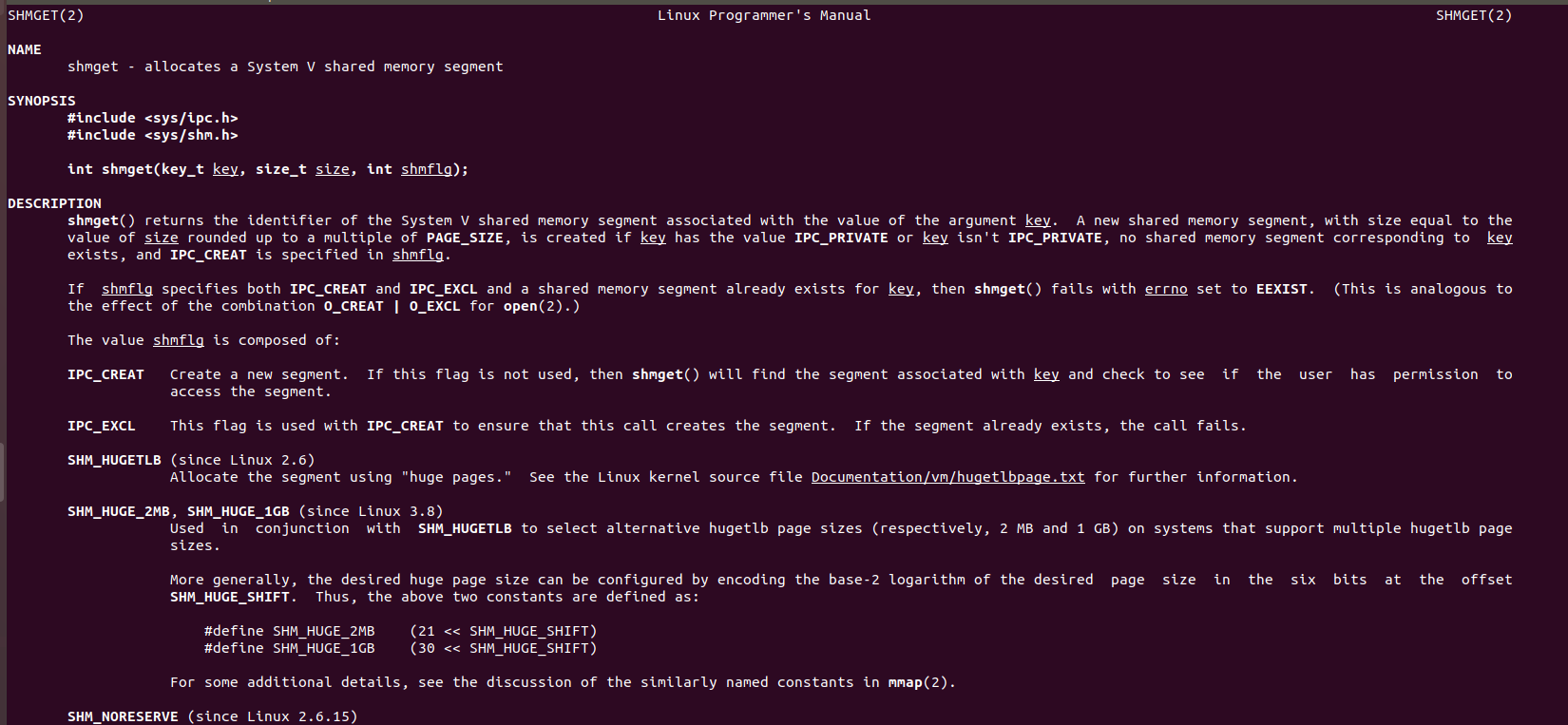
man 2 msgget
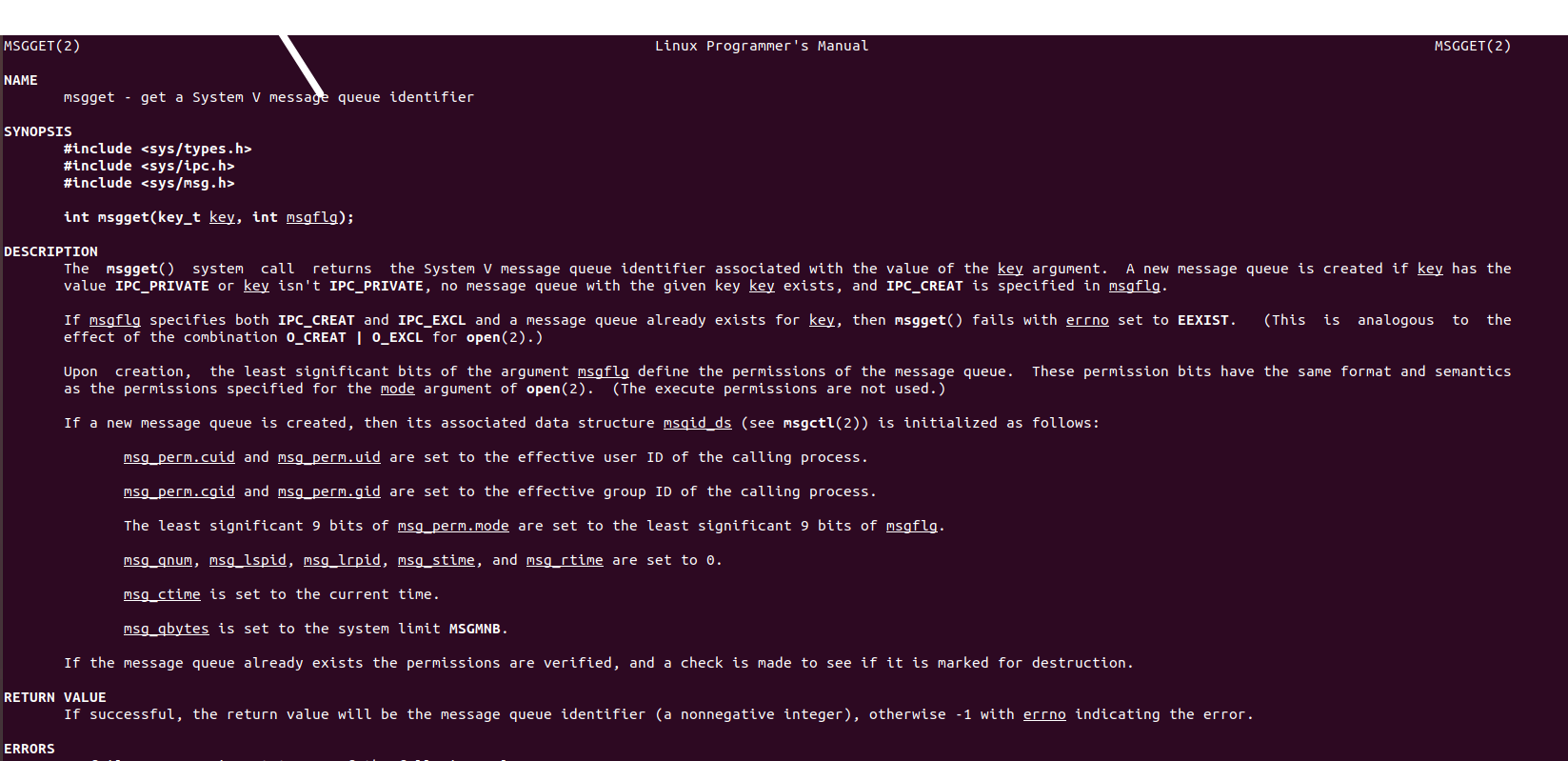
man 2 segget
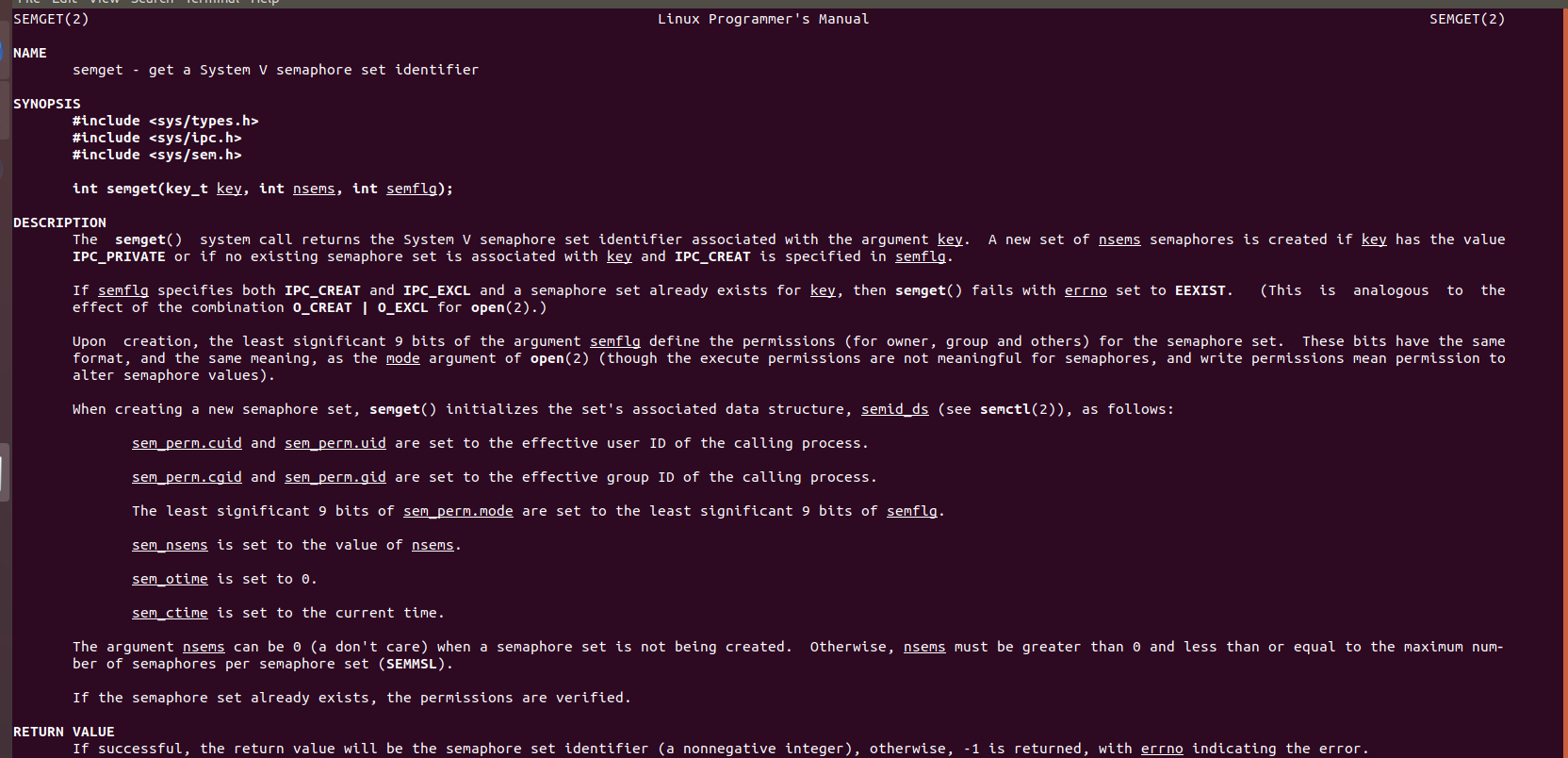
在创建 IPC 内核对象时,用户程序一定需要提供 key 值才行。实际上,创建 IPC 内核对象的函数和获
取内核对象 id 的函数是一样的,都是使用 get 后缀函数。比如在键值 0x8888 上创建 ipc 内核对象,
并获取其 id ,应该像下面这样:
// 在 0x8888 这个键上创建内核对象,权限为 0644,如果已经存在就返回错误。 int id = shmget(0x8888, 4096, IPC_CREAT | IPC_EXCL | 0644); int id = msgget(0x8888, IPC_CREAT | IPC_EXCL | 0644); int id = semget(0x8888, 1, IPC_CREAT | IPC_EXCL | 0644); // 第二个参数表示创建 几个信号量
例题:程序 ipccreate 用于在指定的键值上创建 ipc 内核对象。使用格式为 ./ipccreate ,比如
./ipccreate 0 0x8888 表示在键值 0x8888 上创建共享内存。
// ipccreate.c
#include <unistd.h>
#include <sys/ipc.h>
#include <sys/shm.h>
#include <sys/msg.h>
#include <sys/sem.h>
#include <stdio.h>
#include <stdlib.h>
#include <string.h>
int main(int argc, char* argv[]) {
if (argc < 3) {
printf("%s <ipc type> <key>\n", argv[0]);
return -1;
}
key_t key = strtoll(argv[2], NULL, 16);//key
char type = argv[1][0];//
char buf[64];
int id;
if (type == '0') {//创建共享内存
id = shmget(key, getpagesize(), IPC_CREAT | IPC_EXCL | 0644);
strcpy(buf, "share memory");
}
else if (type == '1') {//创建消息队列
id = msgget(key, IPC_CREAT | IPC_EXCL | 0644);
strcpy(buf, "message queue");
}
else if (type == '2') {//创建信号量
id = semget(key, 5, IPC_CREAT | IPC_EXCL | 0644);
strcpy(buf, "semaphore");
}
else {
printf("type must be 0, 1, or 2\n");
return -1;
}
if (id < 0) {
perror("get error");
return -1;
}
printf("create %s at 0x%x, id = %d\n", buf, key, id);
return 0;
}
![]()
获取 ipc 内核对象
程序 ipcget 用于在指定的键值上获取 ipc 内核对象的 id 号。使用格式为 ./ipcget ,比如
./ipcget 0 0x8888 表示获取键值 0x8888 上的共享内存 id 号。
// ipcget.c
#include <unistd.h>
#include <sys/ipc.h>
#include <sys/shm.h>
#include <sys/msg.h>
#include <sys/sem.h>
#include <stdio.h>
#include <stdlib.h>
#include <string.h>
int main(int argc, char* argv[]) {
if (argc < 3) {
printf("%s <ipc type> <key>\n", argv[0]);
return -1;
}
key_t key = strtoll(argv[2], NULL, 16);
char type = argv[1][0];
char buf[64];
int id;
if (type == '0') {
id = shmget(key, 0, 0);
strcpy(buf, "share memory");
}
else if (type == '1') {
id = msgget(key, 0);
strcpy(buf, "message queue");
}
else if (type == '2') {
id = semget(key, 0, 0);
strcpy(buf, "semaphore");
}
else {
printf("type must be 0, 1, or 2\n");
return -1;
}
if (id < 0) {
perror("get error");
return -1;
}
printf("get %s at 0x%x, id = %d\n", buf, key, id);
return 0;
}

3. 共享内存
man 2 shmop
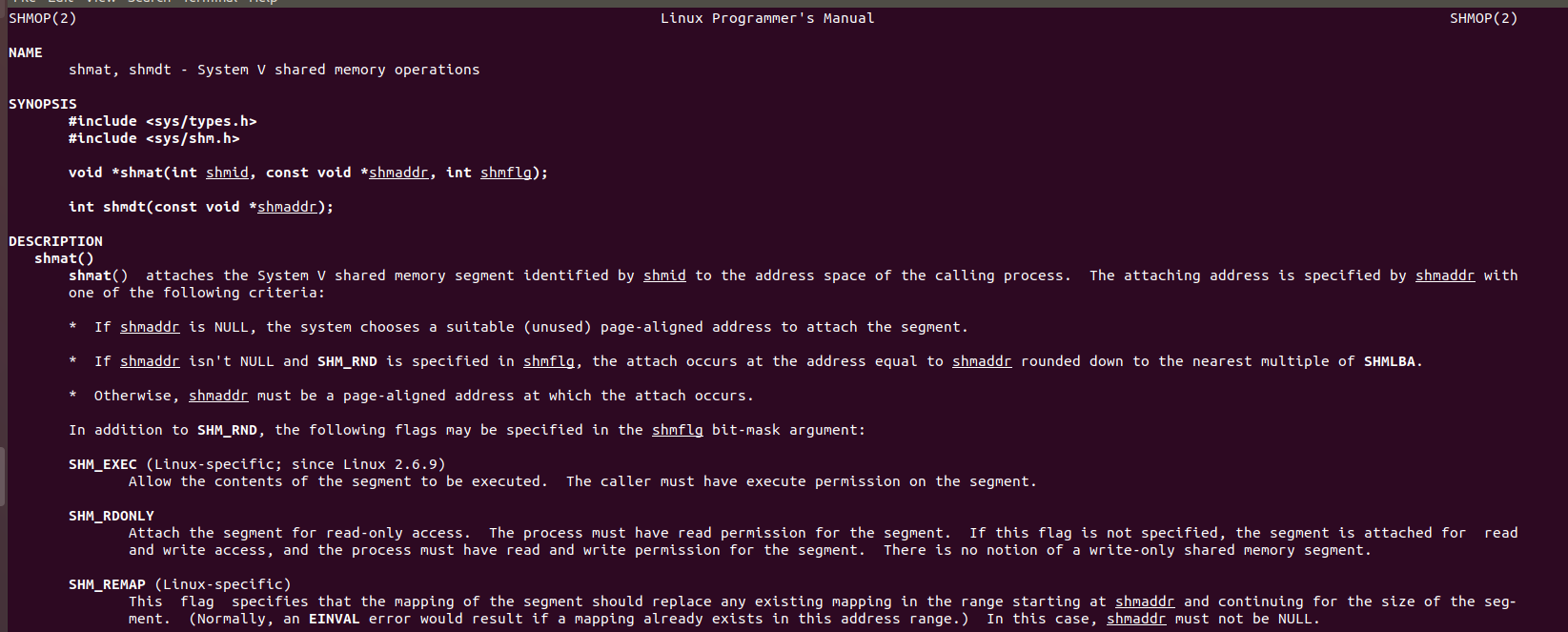
man 2 shmctl
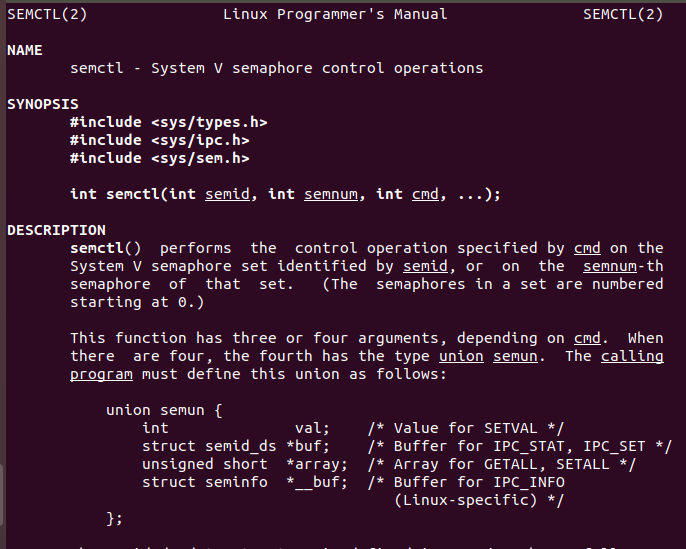
例题:编写一个程序 shmctl 可以用来创建、删除内核对象,也可以挂接、卸载共享内存,还可以打
印、设置内核对象信息。具体使用方法具体见下面的说明:
./shmctl -c : 创建内核对象。
./shmctl -d : 删除内核对象。
./shmctl -v : 显示内核对象信息。
./shmctl -s : 设置内核对象(将权限设置为 0600 )。
./shmctl -a : 挂接和卸载共享内存(挂接 5 秒后,再执行 shmdt ,然后退出)。
// shmctl.c
#include <unistd.h>
#include <sys/ipc.h>
#include <sys/shm.h>
#include <stdio.h>
#include <time.h>
#include <stdlib.h>
#include <string.h>
#define ASSERT(res) if((res)<0){perror(__FUNCTION__);exit(-1);}
// 打印 ipc_perm
void printPerm(struct ipc_perm *perm) {
printf("euid of owner = %d\n", perm->uid);
printf("egid of owner = %d\n", perm->gid);
printf("euid of creator = %d\n", perm->cuid);
printf("egid of creator = %d\n", perm->cgid);
printf("mode = 0%o\n", perm->mode);
}
// 打印 ipc 内核对象信息
void printShmid(struct shmid_ds *shmid) {
printPerm(&shmid->shm_perm);
printf("segment size = %d\n", shmid->shm_segsz);
printf("last attach time = %s", ctime(&shmid->shm_atime));
printf("last detach time = %s", ctime(&shmid->shm_dtime));
printf("last change time = %s", ctime(&shmid->shm_ctime));
printf("pid of creator = %d\n", shmid->shm_cpid);
printf("pid of last shmat/shmdt = %d\n", shmid->shm_lpid);
printf("No. of current attaches = %ld\n", shmid->shm_nattch);
}
// 创建 ipc 内核对象
void create() {
int id = shmget(0x8888, 123, IPC_CREAT | IPC_EXCL | 0664);
printf("create %d\n", id);
ASSERT(id);
}
// IPC_STAT 命令使用,用来获取 ipc 内核对象信息
void show() {
int id = shmget(0x8888, 0, 0);
ASSERT(id);
struct shmid_ds shmid;
ASSERT(shmctl(id, IPC_STAT, &shmid));
printShmid(&shmid);
}
// IPC_SET 命令使用,用来设置 ipc 内核对象信息
void set() {
int id = shmget(0x8888, 123, IPC_CREAT | 0664);
ASSERT(id);
struct shmid_ds shmid;
ASSERT(shmctl(id, IPC_STAT, &shmid));
shmid.shm_perm.mode = 0600;
ASSERT(shmctl(id, IPC_SET, &shmid));
printf("set %d\n", id);
}
// IPC_RMID 命令使用,用来删除 ipc 内核对象
void rm() {
int id = shmget(


